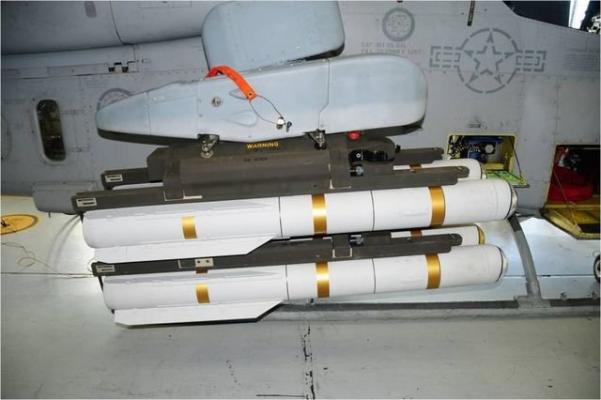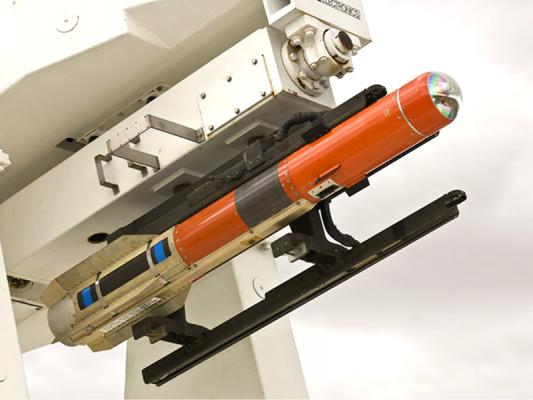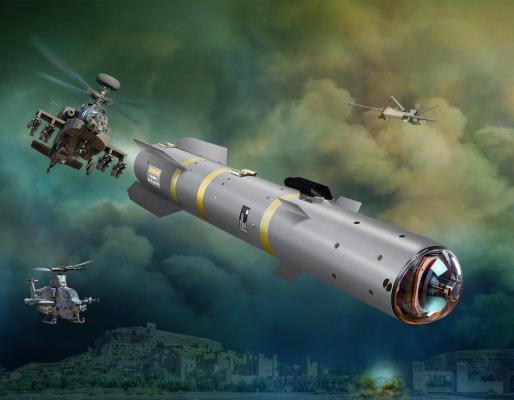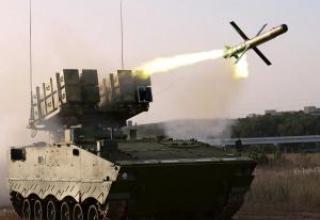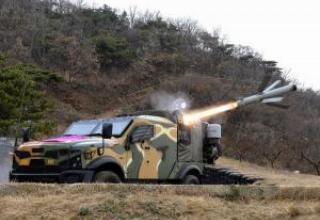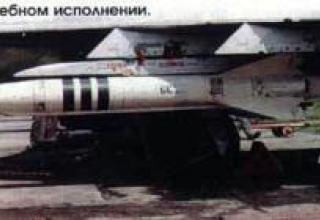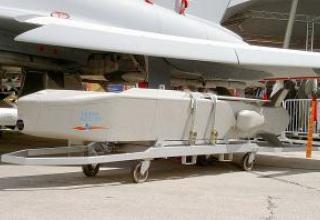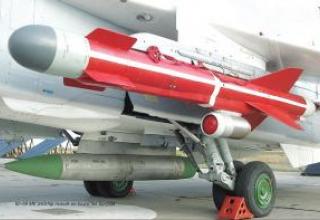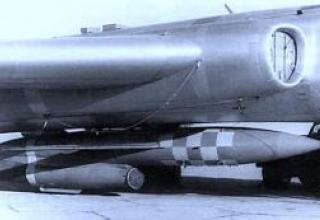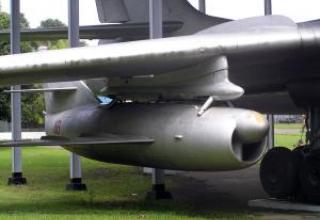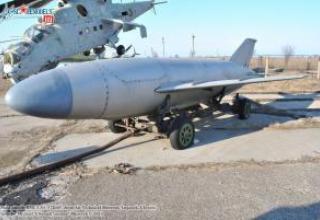Experimental multi-purpose guided missile of air-to-ground class JAGM is designed to engage armored targets, patrol ships, artillery systems, missile launchers, positions of radar stations, control and communication centers, fortifications, infrastructure facilities of settlements and administrative centers of the enemy.
The development of a single unified air-based missile in the interests of the US Army, Navy and Marine Corps under the Joint Air-to-Ground Missile (JAGM) program has been underway since 2007. Two groups of companies participate in the development of JAGM through competitive bidding, led by Lockheed Martin and Raytheon as lead developers. JAGM is a continuation of the AGM-169 Joint Common Missile (JCM) program completed in 2007.
Initially, the U.S. Army planned to pay for the development of the missile by both companies, but due to budget constraints from 2011 chose only one developer - Lockheed Martin. Raytheon continues to develop with its own funds, but it is not ruled out that its work can be resumed from the budget. Thus, the general name JAGM, at present, in fact, means two separate projects, the degree of unification of which is unknown.
The JAGM missile is designed to replace the existing AGM-114L Hellfire Longbow, XGM-71 TOW, AGM-65 Maverick systems and is characterized by greater efficiency, range, operational flexibility, high level of support at lower cost compared to the prototypes.
According to the development specification, JAGM is scheduled to be placed on the following media:
- F/A-18 E/F Super Hornet fighter of the US Navy,
- the AH-64D Apache Longbow;
- the MH-60R Seahawk reconnaissance helicopter of the US Navy,
- U.S. Marine Corps AH-1Z Super Cobra attack helicopter;
- the MQ-1C Gray Eagle;
- the OH-58 CASUP attack reconnaissance helicopter;
- Army multi-purpose unmanned aerial vehicle SkyWarrior
- F-35 Lightning II fighter.
The JAGM missile is scheduled to begin arriving in 2016 as part of the Army's AH64D helicopter, Marine Corps AH 1Z attack helicopter and F/A-18E/F fighter aircraft. The Super Hornet fighter can carry up to 18 JAGM guided missiles, as opposed to four Maverick missiles. Adoption of the JAGM for the MH 60R helicopter, the army's OH-58, the upgraded Kiowa Warrior helicopter and the army's multi-purpose ERMP extended range drone system is scheduled for 2017.
According to preliminary information, only at the initial stage the ground forces, Navy, Air Force and Marine Corps are going to purchase about 35 thousand JAGM, and the total number of purchased missiles may reach 100 thousand. The full cost of the program is about $7 billion.
Composition:
According to published information, the JAGM program was restructured in early 2012 due to budget cuts with the following phases:
- 3 этап (increment 3): разработка нового двигателя, обеспечивающего дальность стрельбы до 16км и пуск УР JAGM с вертолетов и многоцелевых реактивных самолетов.
- Stage 1 (step 1): creation of a dual-channel homing head (Homing Head), combining a laser semi-active and radar homing circuit of the millimeter range and integration of the new Homing Head with the Hellfire-II missile unit and the AGM-114R multi-purpose combat unit. At this stage, we are essentially talking about the development of an upgraded missile that has received the designation Hellfire-III.
- Stage 2 (Phase 2): equipping the JAGM missile with a new three-channel GSN, which combines radar, laser semi-active and thermal homing channels. Increasing the flight range to 12 km.
- Phase 3 (increment 3): development of a new engine that provides a range of up to 16 km and the launch of JAGM from helicopters and multi-purpose jets.
Raytheon-Boeing Consortium JAGM Project
According to the division of labor adopted in this project, Boeing is responsible for the development of the hull and head of the missile, and Raytheon is responsible for the development of a homing system.
The JAGM features a fully integrated homing head (Homing Head) that includes channels for active radar, thermal imaging and semi-active laser homing. The thermal imaging channel is equipped with a matrix of uncooled infrared detectors located in the focal plane of the optical system and providing an image of the target. The active radar channel of the CNS operates in the millimeter range.
JAGM widely uses elements of the design of products previously developed - small caliber bomb GBU-53/B (Small Diameter Bomb II) and Brimstone missile, which reduces the development cost of a new missile and technical risks.
Complexing the CNS channels provides the missile's homing system with high accuracy and immunity to interference, including in conditions of intense radioactivity, the use of camouflage means and adverse weather conditions.
The missile's CNS target can be captured after launch, or before launch. In the first case, at the initial flight section, the missile's movement is controlled by an inertial control system with the possibility of transmitting target designation commands via a data transmission line supplemented by a satellite navigation system. The ability to capture the target after launch allows to implement a 'shot-forget' mode at long ranges, including for mobile targets, which dramatically increases the survivability of the carrier.
The missile has a modular design. The single-chamber rocket engine is equipped with a charge of low-smoke fuel and developed by Boeing and Alliant Techsystems (ATK). The refined tandem cumulated-shrapnel combat unit is optimized to engage a wide range of targets, including armored and surface targets.
Lockheed Martin JAGM Project
According to published data, in 2012 Lockheed Martin started testing a dual-channel CNS (increment 1), which includes radar and laser channels.
Work is planned on its own combined three-channel JAGM homing head, which includes: an advanced semi-active laser guidance system, radar active guidance system operating in the millimeter wavelength range and thermal guidance system. The sensors of the thermal guidance system are cooled by a special system developed by Marotta Controls when the missile is suspended on the carrier.
According to the developer, the new CNS allows the JAGM missile to engage a wide range of stationary and moving targets regardless of weather conditions, and the ability to use the "shot and forget" principle significantly increases the survivability of the carrier and combat efficiency, including the failure of the GPS system and active radioelectronic countermeasures of the enemy.
When creating the new missile, the development companies widely used the technology of the combat unit and fuse of guided missile AGM-114R.
The rocket engine is single-chamber, developed by Aerojet and equipped with a charge of rocket fuel with reduced smoke formation. Rocket fuel used in the missile JAGM, similar to the fuel of aircraft missile AIM-120, but has a reduced combustion rate. Lockheed Martin Corporation uses the same approach in the engine design of the Orion spacecraft's emergency rescue system.
Characteristics:
| Length, mm | 1800 |
| Body diameter, mm | 178 |
| Wingspan, mm | 325 |
| Weight, kg | 48.9 |
| Maximum range, km | 28 (16 for the helicopter) |
Testing:
The chronicle provides the dates of publication in the sources indicated below.
29.01.2010г. Raytheon and Boeing announced the successful completion of a series of bench tests of the new JAGM guided missile.
31.03.2010г. Lockheed Martin Corporation has successfully completed a series of tests of the JAGM guided missile homing head. During the tests it was demonstrated that all the circuits of the CNS - thermal imaging, semi-active laser and radar - can operate simultaneously. Additional bench tests of the CNS under the influence of thermal, vibration and electromagnetic interference corresponding to the real flight are planned for 2010.
13.04.2010г. Raytheon and Boeing announced the completion of the second series of bench tests as part of the JAGM guided missile competition. The press release informs about the successful combination of the most technically complicated CNS circuits - thermal and radar.
20.04.2010г. Raytheon and Boeing performed the first launch of a JAGM guided missile from a ground-based launcher simulating a helicopter carrier (see photo). The rocket performed a number of programmed maneuvers and flew to the specified area. Tests confirmed the correctness of the developed control system software.
05.05.2010г. Lockheed Martin has successfully completed a series of tests of the JAGM missile launch system from the F/A-18 E/F Super Hornet fighter in various suspension variants. The tests were conducted on the wind tunnel of the National Aeronautics and Space Administration Ames Research Center in Mofett Field, California. More than 200 hours of testing confirmed the minimal changes in the characteristics of the carrier controllability.
Earlier Lockheed Martin specialists conducted a series of F/A-18E/F payloads tests in the wind tunnel of Arnold Design Center in Tullahoma (Tennessee, USA). The total time was 150 hours. The data obtained are used to clarify the requirements for the design of the launcher and the JAGM missile.
The safe launch of the JAGM rocket from the F/A-18 E/F was tested at the Arnold Center site. The tests evaluated the design of the three-rail launcher developed by Lockheed Martin and Marvin Engineering. Subsequent tests in a Boeing Vetrol wind tunnel in Philadelphia, Pennsylvania, USA, demonstrated and confirmed the performance of the JAGM-guided Super Hornet fighter at low speeds.
05.05.2010г. Specialists from Raytheon and Boeing have completed a series of tests of guided missile JAGM in a wind tunnel. The tests confirmed the possibility of installing the JAGM missile on the console suspension point of the F/A-18 E/F Super Hornet fighter.
26.07.2010г. Raytheon and Boeing announced the completion of a series of three launches of the JAGM missile. During the tests, a laser channel of the rocket's homing system was used to hit a target of 8 x 8 feet (243.84 x 243.84 cm) from a distance of 16 kilometers.
02.08.2010г. Lockheed Martin has successfully tested a semi-active laser channel of combined CNS. During the tests, the missile hit a target with an angle of 20° at a range of 16 km. The target was illuminated by a ground laser designator at a distance of 1.1 km.
01.09.2010г. Raytheon and Boeing completed the second series of three JAGM launches. The thermal loop of the homing system was used to hit the target located at a distance of 4 km. The tests were funded by the US government.
26.10.2010г. Raytheon and Boeing completed the flight test of an overhead missile launcher for JAGM and a telemetry missile on an F/A-18 E/F Super Hornet fighter. The JAGM pendant launch vehicle is based on Boeing's BRU-33 launcher.
08.11.2010 г. Raytheon and Boeing announced the next successful launch of the JAGM technology demonstrator. The tests were funded by the developers' companies. The next step was the beginning of the development and production phase.
22.11.2010г. Flight tests of the missile developed by Lockheed Martin under the JAGM program, conducted at the White Sands Missile Range, demonstrated the performance of the infrared channel of the three-channel CNS in the target acquisition mode before launch. The infrared sensor of the CNS reliably captured the target, the main tank, before launch at a distance of 6 km. The tests confirmed the correct operation of the CNS in difficult interference conditions. After launch, the active radar channel of the COS detected secondary targets moving with the main target in the column. During the flight, the homing system reliably identified the primary target and ensured its defeat. It was launched from a fixed HELLFIRE M299 launcher.
03.01.2011г. Lockheed Martin announced the successful completion of a series of tests of the U.S. Navy F/A-18E/F Super Hornet fighter with JAGM missile suspension. In the period from 05.10.2010 to 02.11.2010 six flights were performed from the airfield of the Navy "Patuxent River" (Maryland, USA). The total flight time amounted to 11.2 hours. The fighter was tested at altitudes ranging from 5,000 to 35,000 feet (1,524 to 1,0668 meters) with speeds up to one Mach.
Six telemetry rockets were used, mounted on two three-rail PU designed by Lockheed Martin and Marvin Engineering. The units were tested in various suspension variants with other weapon systems and external fuel tanks.
14.04.2011г. Lockheed Martin Corporation has been selected as the lead developer of the JAGM guided missile. The Aerojet company of GenCorp Corporation provides development of the rocket engine, Ark. Marvin Engineering - launcher, General Dynamics Ordnance and Tactical Systems (GD-OTS) - multi-purpose combat unit with a high degree of harmonization with HELLFIRE BC.
The U.S. Air Force Command has issued a request for the engineering phase and initial small-scale production of the JAGM missile.
02.05.2011г. Raytheon and Boeing have completed a series of temperature tests of the JAGM single chamber engine developed by Boeing and ATK. The engines were subjected to multiple cycles (from 5 to 20 times) with a temperature range of -45 to 160 ° F and fully maintained their performance. The work is funded by the U.S. government.
06.06.2011г. Raytheon and Boeing submitted their JAGM missile proposals for the U.S. Army and Navy. The companies confirmed the characteristics that were obtained during the testing phase of the JAGM technology demonstrator. The uncooled, three-mode homing head of the missile is fully integrated with the launch vehicle's combat environment display system.
07.06.2011г. Lockheed Vartin's three-mode homing head successfully captured and escorted several moving maritime targets during the flight tests. The tests were conducted in the Gulf of Mexico in the area of U.S. Air Force Base "Eglin". One of the maritime targets was a modern low-visibility high-speed ship RAC (Revenge Advanced Composites). RAC performed a series of evasive maneuvers from the JAGM homing head mounted on the bow of the Sabreliner Series 60 fighter. The results obtained made it possible to assess the effectiveness of the CLO for marine targets at maximum ranges in the shot for nothing mode. The carrier's flight speed reached 400 knots and altitude was 20,000 feet.
During the trials, the capabilities of the JAGM rocket to operate under maritime conditions were also assessed. The tests were financed by the company's own funds.
06.06.2011г. In response to a request from the U.S. government, Lockheed Martin announced the release of proposals for the next phases of the JAGM program.
13.07.2011г. Raytheon announced the completion of temperature tests on the fifth and sixth rocket engine of the JAGM missile. The engines were exposed to temperatures down to -65 ° F, as well as vibration loads corresponding to different modes of flight of the helicopter carrier, and maintained their performance.
24.08.2011г. Raytheon and Boeing completed tests of the JAGM rocket engine developed by Boeing and ATK. During the tests, the engine samples were loaded with 15 and 20 temperature cycles ranging from -50 to +160°F. The test program also included a vibration test cycle equivalent to 300 flight hours. The JAGM missile then successfully passed six firing tests, including three direct hits to the target.
02.11.2011г. Lockheed Martin Corporation announced the first test burn of a JAGM rocket engine equipped with a fuel with reduced smoke emission. The engine, developed by Aerojet, successfully operated within the specified period, reaching design levels of thrust and reliability. The smoke-reduced rocket fuel is a version of the fuel used in the AIM-120 rocket engine. When used in the engine of the JAGM missile, it required some modification to reduce the combustion rate.
06.12.2011г. Lockheed Martin and Marotta Controls completed a test of the air cooling system for the JAGM missile launcher. The cooling system, which includes a miniature compressor and filtration system, cools the infrared sensor of the JAGM missile when it is placed on the launcher. The projected average operating time between failures is more than 10,000 hours, far exceeding the required operating time of 2,500 hours. The volume of deliveries is more than 1000 systems.
23.10.2012г. Lockheed Martin Corporation has successfully performed flight tests of the dual-mode homing head for the JAGM guided missile (increment 1). During the tests it was demonstrated the ability to track ground targets during the flight at tactical speeds. The tests were performed from a Sabreliner fighter aircraft at Yuma Firing Range (Arizona, USA) and confirmed the data on the maximum range of typical targets capture by radar and laser circuit of the missile's homing system. The tests were financed by the company's own funds.
20.02.2014г. Lockheed Martin Corporation announced another successful test of the dual-mode homing head of the developing JAGM missile (increment 1). During the tests on the territory of Eglin Air Base (Florida, USA) at a range of 6 km a moving target illuminated by a laser designator was destroyed. The conducted flight tests are part of Lockheed Martin Corporation's own program.
13.07.2015г. Lockheed Martin Corporation reported two successful government-supported flight tests, a prototype JAGM three-mode homing missile, conducted at Eglin Air Base, Florida, USA.
During the first test, the prototype rocket flew four kilometers, engaged a semi-active laser guidance mode and hit a stationary target. During the second flight, the missile flew four kilometres, captured a target in semi-active laser guidance mode and simultaneously escorted the target with the CNS radar channel, hitting a stationary target.
25.05.2016г. First launch of JAGM rocket from the MQ-1C Gray Eagle drone. At the "Daguay" range in Utah, the rocket hit a truck moving at a speed of about 35 kilometers per hour. The distance from the drone to the target truck was over eight kilometers.
Sources:
- URL: http://breakingdefense.com/2013/10/eye-on-fewer-drone-civilian-deaths-mbda-challenges-lockheed-raytheon-with-brimstone-missile/
- URL: http://breakingdefense.com/tag/jagm/
- URL: http://breakingdefense.com/wp-content/uploads/sites/3/2011/08/raytheonjagmmissile.jpg
- URL: http://breakingdefense.com/wp-content/uploads/sites/3/2013/10/brimstone-schematic.jpg
- URL: http://gespenst.egloos.com/v/5398768
- URL: http://lockheedmartin.com/us/news/press-releases/2010/november/LMsJAGMHitsTargetFrom6Kil.html
- URL: http://lockheedmartin.com/us/news/press-releases/2011/december/LMsJAGMCoolingSystemCompl.html
- URL: http://lockheedmartin.com/us/news/press-releases/2011/june/LockheedMartinDemonstrate.html
- URL: http://lockheedmartin.com/us/news/press-releases/2011/november/LockheedMartinDemonstrate.html
- URL: http://lockheedmartin.com/us/news/press-releases/2012/october/mfc-102312-lm-demonstratesJAGM.html
- URL: http://lockheedmartin.com/us/news/press-releases/2014/february/mfc-22014-jagm-dual-mode-guidance-section-flight-test.html
- URL: http://media.al.com/42/photo/jagm-testjpg-f96ac1864a2da883.jpg
- URL: http://raytheon.mediaroom.com/index.php?s=43&item=1486
- URL: http://raytheon.mediaroom.com/index.php?s=43&item=1542
- URL: http://raytheon.mediaroom.com/index.php?s=43&item=1555
- URL: http://raytheon.mediaroom.com/index.php?s=43&item=1615
- URL: http://raytheon.mediaroom.com/index.php?s=43&item=1632
- URL: http://raytheon.mediaroom.com/index.php?s=43&item=1681
- URL: http://raytheon.mediaroom.com/index.php?s=43&item=1696
- URL: http://raytheon.mediaroom.com/index.php?s=43&item=1817
- URL: http://raytheon.mediaroom.com/index.php?s=43&item=1831
- URL: https://missilery.info/news/edinuyu-raketu-lockheed-martin-proverili-na-sovmestimost-s-super-hornet/
- URL: https://missilery.info/news/kompaniya-lockheed-martin-vypuctila-predlozhenie-po-rakete-jagm/
- URL: https://missilery.info/news/kompaniya-lockheed-martin-budet-otvetstvennoy-za-zapros-po-ur-jagm/
- URL: http://semanticommunity.info/@api/deki/files/16661/Figure_2_Joint_Air-to-Ground_Missile_%28JAGM%29.png?origin=mt-web
- URL: http://semanticommunity.info/@api/deki/files/16662/Figure_1_Joint_Air-to-Ground_Missile_%28JAGM%29.png?size=bestfit&width=1000&height=771&revision=1
- URL: http://semanticommunity.info/Army_Weapon_Systems_Handbook_2012/Joint_Air-to-Ground_Missile_%28JAGM%29
- URL: http://www.al.com/42/index.ssf/2011/05/raytheon-boeing_team_achieves.html
- URL: http://www.armstrade.org/includes/periodics/news/2011/0406/16107777/detail.shtml
- URL: http://www.lockheedmartin.com/content/dam/lockheed/data/mfc/photo/jagm/mfc-jagm-photo-main-h.jpg
- URL: http://www.lockheedmartin.com/content/dam/lockheed/data/mfc/photo/jagm/mfc-jagm-photo-05-m.jpg
- URL: http://www.lockheedmartin.com/content/dam/lockheed/data/mfc/photo/jagm/mfc-jagm-photo-01-m.jpg
- URL: http://www.lockheedmartin.com/content/dam/lockheed/data/mfc/photo/jagm/mfc-jagm-photo-02-m.jpg
- URL: http://www.lockheedmartin.com/content/dam/lockheed/data/mfc/photo/jagm/mfc-jagm-photo-03-m.jpg
- URL: http://www.lockheedmartin.com/content/dam/lockheed/data/mfc/photo/jagm/mfc-jagm-photo-04-m.jpg
- URL: http://www.lockheedmartin.com/content/dam/lockheed/data/mfc/photo/jagm/mfc-jagm-photo-07-m.jpg
- URL: http://www.lockheedmartin.com/content/dam/lockheed/data/mfc/photo/jagm/mfc-jagm-photo-09-m.jpg
- URL: http://www.lockheedmartin.com/us/news/press-releases/2010/april/lockheed-martin_s-joint-air-to-ground-missile--jagm--successfull.html
- URL: http://www.lockheedmartin.com/us/news/press-releases/2010/march/LockheedMartinSuccessfull.html
- URL: http://www.lockheedmartin.com/us/news/press-releases/2010/may/LockheedMartinsJointAir--.html
- URL: http://www.lockheedmartin.com/us/products/JAGM.html
- URL: http://www.newscom.com/nc/clearOpenSearch.action?specialsearch=20100420/NE88948
- URL: http://www.raytheon.com/newsroom/technology_today/archive/2012_i2.pdf
- URL: http://www.richardcyoung.com/politics/joint-air-to-ground-missile-jagm/
- URL: http://www.richardcyoung.com/wp-content/uploads/2011/05/JAGM.png
- URL: http://lockheedmartin.com/us/news/press-releases/2015/july/mfc-071315-lockheed-martin-jagm-two-for-two-flight-tests.html
